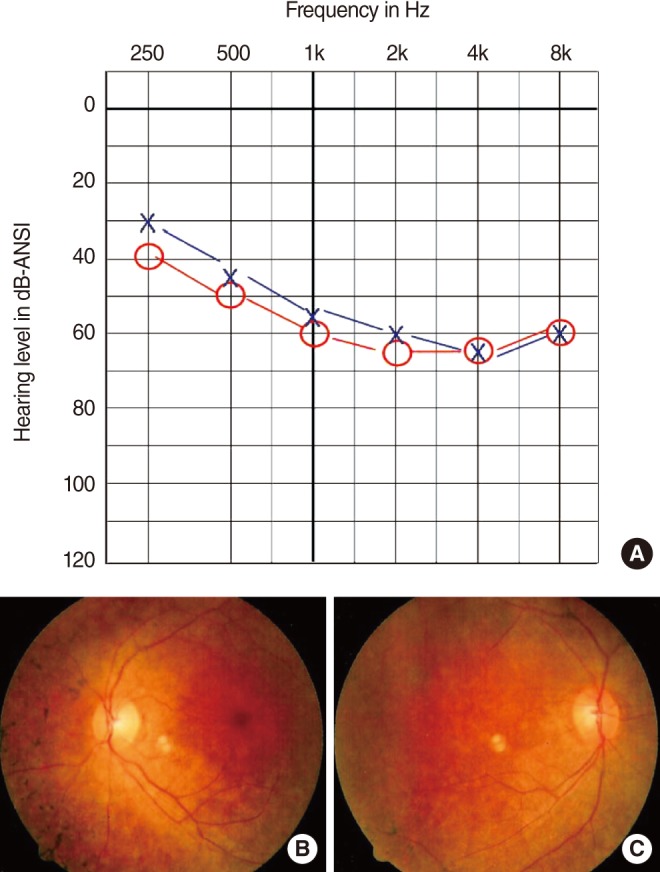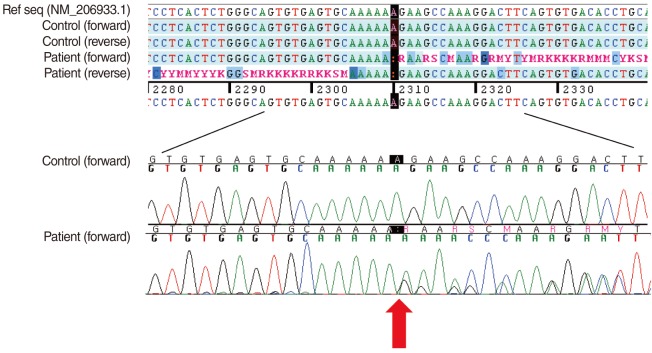Clin Exp Otorhinolaryngol.
2013 Mar;6(1):41-44.
A Novel Frameshift Mutation of the USH2A Gene in a Korean Patient with Usher Syndrome Type II
- Affiliations
-
- 1Department of Otorhinolaryngology, Masan Samsung Hospital, Sungkyunkwan University School of Medicine, Masan, Korea.
- 2Department of Laboratory Medicine & Genetics, Samsung Medical Center, Sungkyunkwan University School of Medicine, Seoul, Korea. heejinkim@skku.edu
- 3Department of Otorhinolaryngology-Head and Neck Surgery, Samsung Medical Center, Sungkyunkwan University School of Medicine, Seoul, Korea. sunghwa3574.hong@samsung.com
Abstract
- Usher syndrome type II (USH2) is the most common form of Usher syndrome, characterized by moderate to severe hearing impairment and progressive visual loss due to retinitis pigmentosa. It has been shown that mutations in the USH2A gene are responsible for USH2. The authors herein describe a 34-year-old Korean woman with the typical clinical manifestation of USH2; she had bilateral hearing disturbance and progressive visual deterioration, without vestibular dysfunction. Molecular genetic study of the USH2A gene revealed a novel frameshift mutation (c.2310delA; Glu771LysfsX17). She was heterozygous for this mutation, and no other mutation was found in USH2A, suggesting the possibility of an intronic or large genomic rearrangement mutation. To the best of our knowledge, this is the first report of a genetically confirmed case of USH2 in Korea. More investigations are needed to delineate genotype-phenotype correlations and ethnicity-specific genetic background of Usher syndrome.
Keyword
MeSH Terms
Figure
Reference
-
1. Sadeghi M, Cohn ES, Kelly WJ, Kimberling WJ, Tranebjoerg L, Moller C. Audiological findings in Usher syndrome types IIa and II (non-IIa). Int J Audiol. 2004; 3. 43(3):136–143. PMID: 15198377.
Article2. Sankila EM, Pakarinen L, Kaariainen H, Aittomaki K, Karjalainen S, Sistonen P, et al. Assignment of an Usher syndrome type III (USH3) gene to chromosome 3q. Hum Mol Genet. 1995; 1. 4(1):93–98. PMID: 7711740.
Article3. Ahmed ZM, Riazuddin S, Khan SN, Friedman PL, Riazuddin S, Friedman TB. USH1H, a novel locus for type I Usher syndrome, maps to chromosome 15q22-23. Clin Genet. 2009; 1. 75(1):86–91. PMID: 18505454.
Article4. Bernal S, Meda C, Solans T, Ayuso C, Garcia-Sandoval B, Valverde D, et al. Clinical and genetic studies in Spanish patients with Usher syndrome type II: description of new mutations and evidence for a lack of genotype--phenotype correlation. Clin Genet. 2005; 9. 68(3):204–214. PMID: 16098008.
Article5. Boo SH, Park DJ, Han CS. A case of type 2 usher syndrome. Korean J Otorhinolaryngol-Head Neck Surg. 2008; 9. 51(9):833–837.6. Eudy JD, Weston MD, Yao S, Hoover DM, Rehm HL, Ma-Edmonds M, et al. Mutation of a gene encoding a protein with extracellular matrix motifs in Usher syndrome type IIa. Science. 1998; 6. 280(5370):1753–1757. PMID: 9624053.
Article7. Pennings RJ, Te Brinke H, Weston MD, Claassen A, Orten DJ, Weekamp H, et al. USH2A mutation analysis in 70 Dutch families with Usher syndrome type II. Hum Mutat. 2004; 8. 24(2):185. PMID: 15241801.
Article8. van Wijk E, Pennings RJ, te Brinke H, Claassen A, Yntema HG, Hoefsloot LH, et al. Identification of 51 novel exons of the Usher syndrome type 2A (USH2A) gene that encode multiple conserved functional domains and that are mutated in patients with Usher syndrome type II. Am J Hum Genet. 2004; 4. 74(4):738–744. PMID: 15015129.9. Dreyer B, Brox V, Tranebjaerg L, Rosenberg T, Sadeghi AM, Moller C, et al. Spectrum of USH2A mutations in Scandinavian patients with Usher syndrome type II. Hum Mutat. 2008; 3. 29(3):451. PMID: 18273898.
Article
- Full Text Links
- Actions
-
Cited
- CITED
-
- Close
- Share
- Similar articles
-
- Severe or Profound Sensorineural Hearing Loss Caused by Novel USH2A Variants in Korea: Potential Genotype-Phenotype Correlation
- A Case of Type 2 Usher Syndrome
- A frameshift mutation in the TRPS1 gene showing a mild phenotype of trichorhinophalangeal syndrome type 1
- Novel LMNA Gene Mutation in a Patient With Atypical Werner's Syndrome
- A Case of Familial Isolated Primary Hyperparathyroidism with a Novel Gene Mutation



